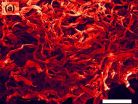(Press-News.org) WASHINGTON, DC - A medicinal liquid form of marijuana may show promise as a treatment for children with severe epilepsy that is not responding to other treatments, according to a study released today that will be presented at the American Academy of Neurology's 67th Annual Meeting in Washington, DC, April 18 to 25, 2015.
The study involved 213 people, ranging from toddlers to adults, with a median age of 11 who had severe epilepsy that did not respond to other treatments. Participants had Dravet syndrome and Lennox-Gastaut syndrome, epilepsy types that can lead to intellectual disability and lifelong seizures, as well as 10 other types of severe epilepsy.
The participants were given the drug cannabidiol, a component of marijuana that does not include the psychoactive part of the plant that creates a "high." The drug is a liquid taken daily by mouth. Participants all knew they were receiving the drug in the open-label study, which was designed to determine whether the drug was safe and tolerated well.
Researchers also measured the number of seizures participants had while taking the drug. For the 137 people who completed the 12-week study, the number of seizures decreased by an average of 54 percent from the beginning of the study to the end. Among the 23 people with Dravet syndrome who finished the study, the number of convulsive seizures had gone down by 53 percent by the end of the study. For the 11 people with Lennox-Gastaut syndrome who finished the study, there was a 55 percent reduction in the number of atonic seizures, which cause a sudden loss of muscle tone.
A total of 12 people, or 6 percent, stopped taking the drug due to side effects. Side effects that occurred in more than 10 percent of participants included drowsiness (21 percent), diarrhea (17 percent), tiredness (17 percent) and decreased appetite (16 percent).
Study author Orrin Devinsky, MD, of New York University Langone Comprehensive Epilepsy Center and a Fellow of the American Academy of Neurology, said that these are early findings and larger, placebo-controlled, double-blind trials are needed to measure the effectiveness of the drug.
"So far there have been few formal studies on this marijuana extract," Devinsky said. "These results are of great interest, especially for the children and their parents who have been searching for an answer for these debilitating seizures."
INFORMATION:
The study was supported by GW Pharmaceuticals.
To read the AAN's systematic review regarding epilepsy and brain disorders, please visit http://www.neurology.org/content/82/17/1556.full. To learn more about epilepsy, please visit http://www.aan.com/patients.
The American Academy of Neurology, an association of more than 28,000 neurologists and neuroscience professionals, is dedicated to promoting the highest quality patient-centered neurologic care. A neurologist is a doctor with specialized training in diagnosing, treating and managing disorders of the brain and nervous system such as Alzheimer's disease, stroke, migraine, multiple sclerosis, brain injury, Parkinson's disease and epilepsy.
For more information about the American Academy of Neurology, visit http://www.aan.com or find us on Facebook, Twitter, Google+ and YouTube.
Editor's Note:
Dr. Devinsky will present his findings at 6:15 p.m. ET, on Wednesday, April 22, 2015, in Ballroom C of the Walter E. Washington Convention Center in Washington, DC.
Please contact Rachel Seroka, rseroka@aan.com, to schedule an advance interview.
To access Non-Emerging Science abstracts to be presented at the 2015 AAN Annual Meeting, visit http://www.abstracts2view.com/aan/. Emerging Science abstracts are embargoed until 12:01 a.m., ET, Friday, April 17, 2015, unless otherwise noted by the Academy's Media and Public Relations Department.
Tropical Cyclone Solo was dissipating over the Southwestern Pacific Ocean when NASA's Aqua satellite passed overhead on April 13, 2015.
On April 11 Tropical Cyclone Solo spawned warnings in New Caledonia as it passed by. By April 12, the warnings were dropped and wind shear had taken its toll on the storm weakening it.
On April 12 at 0300 UTC (April 11 at 11 p.m. EDT), the Joint Typhoon Warning Center (JTWC) issued their final bulletin on Solo. At that time it was 116 nautical miles north of Noumea, New Caledonia near 20.2 south latitude and 165.7 east longitude. Solo ...
Skin is remarkably resistant to tearing and a team of researchers from the University of California, San Diego and the Lawrence Berkeley National Laboratory now have shown why.
Using powerful X-ray beams and electron microscopy, researchers made the first direct observations of the micro-scale mechanisms that allow skin to resist tearing. They identified four specific mechanisms in collagen, the main structural protein in skin tissue, that act together to diminish the effects of stress: rotation, straightening, stretching, and sliding. Researchers say they hope to replicate ...
TAMPA, Fla. - Moffitt Cancer Center researchers have developed a new method to identify a previously unknown structure in a protein called MDMX. MDMX is a crucial regulatory protein that controls p53 - one of the most commonly mutated genes in cancer.
Known as the tumor suppressor gene, p53 protects the body from cancer development by ensuring that DNA remains intact and does not have mutations. If p53 senses DNA damage, it can either stimulate the cells to repair its DNA, or cause cells to stop growing and undergo cell death. Because of its functions, p53 is often ...
ATLANTA--Chimpanzees are capable of some degree of planning for the future, in a manner similar to human children, while some species of monkeys struggle with this task, according to researchers at Georgia State University, Wofford College and Agnes Scott College.
Their findings were published on March 23 in the Journal of Comparative Psychology.
The study assessed the planning abilities of chimpanzees, two monkey species (rhesus macaques and capuchin monkeys) and human children (ages 28 to 66 months old) using a computerized game-like program that presented 100 unique ...
A workplace intervention designed to reduce work-family conflict gave employed parents more time with their children without reducing their work time.
"These findings may encourage changes in the structure of jobs and culture of work organizations to support families," said Kelly Davis, research assistant professor of human development and family studies.
The research is part of the Work, Family and Health Network's evaluation of the effects of a workplace intervention designed to reduce work-family conflict by increasing both employees' control over their schedule ...
(Boston) - Emergency departments (ED) provide a promising venue to address opioid deaths with education on both overdose prevention and appropriate actions in a witnessed overdose. In addition, ED's have the potential to equip patients with nasal naloxone rescue kits as part of this effort.
These findings are from a study published in the Western Journal of Emergency Medicine, and is the first study to demonstrate the feasibility of ED-based opioid overdose prevention education and naloxone distribution to trained laypersons, patients and their social network.
In ...
PROVIDENCE, R.I. [Brown University] -- Researchers from Brown University and the University of Rhode Island have demonstrated a promising new way to increase the effectiveness of radiation in killing cancer cells.
The approach involves gold nanoparticles tethered to acid-seeking compounds called pHLIPs. The pHLIPs (pH low-insertion peptides) home in on high acidity of malignant cells, delivering their nanoparticle passengers straight to the cells' doorsteps. The nanoparticles then act as tiny antennas, focusing the energy of radiation in the area directly around the cancer ...
CORVALLIS, Ore. - Researchers at Oregon State University have discovered how vitamin E deficiency may cause neurological damage by interrupting a supply line of specific nutrients and robbing the brain of the "building blocks" it needs to maintain neuronal health.
The findings - in work done with zebrafish - were just published in the Journal of Lipid Research. The work was supported by the National Institutes of Health.
The research showed that zebrafish fed a diet deficient in vitamin E throughout their life had about 30 percent lower levels of DHA-PC, which is a ...
PITTSBURGH, April, 13, 2015 - A serendipitous combination of technology and scientific discovery, coupled with a hunch, allowed University of Pittsburgh Cancer Institute (UPCI) researchers to reveal a previously invisible biological process that may be implicated in the rapid growth of some cancers.
The project, funded by the National Institutes of Health (NIH), is described in today's issue of the Proceedings of the National Academy of Sciences (PNAS).
"I was so amazed by what I was seeing," said lead author Masahiro Shuda, Ph.D., research assistant professor in Pitt's ...
HOUSTON - (April 13, 2015) - For decades, scientists and physicians have puzzled over the fact that infants with the postnatal neurodevelopmental disorder Rett syndrome show symptoms of the disorder from one to two years after birth.
In a report in the Proceedings of the National Academy of Sciences, Dr. Huda Zoghbi and her colleagues from Baylor College of Medicine and the Jan and Dan Duncan Neurological Research Institute at Texas Children's Hospital, unravel the mystery by looking at when and how the causal gene involved (methyl-CpG binding protein 2 or MECP2) binds ...


